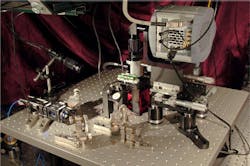A team of researchers from the University of Colorado’s physics department has developed a high-resolution projection and imaging system for ultra-cold atoms built from commercially available components.
Bose-Einstein condensation is a state of matter of a dilute gas of bosons cooled to temperatures close to absolute zero (-273.15°C or -459.67 F). The process was first demonstrated in 1995, and since then, ultra-cold matter has become an area of scientific focus. Global research is working to establish a high level of understanding of the underlying physics for ultra-cold matter applications, and teams are beginning to design and build compact, low-power instrumentation for handling the ultra-cold atoms, according to a press release.
The team from Colorado placed a silicon and glass atom chip in the heart of the system. This metallized chip enables magnetic trapping while the glass regions enable holographically-generated light patterns to optically slice the magnetic trap into separate regions. Up to four Bose-condensates have been generated simultaneously and fluorescent images of the process were captured on an Andor iXon EMCCD camera.
"Our research is aimed at developing “atomtronic" devices, atomic analogues to semiconductor-based electronics, such as transistors and diodes, which can be used to fabricate atomic circuits with real commercial applications," said Dr. Evan Salim. "All of them will rely on quantum mechanical tunneling of atoms through potential barriers and we must be able to detect and manipulate the atoms at micron or sub-micron scales. Our system greatly simplifies the process and enables a more flexible and robust device.”
Andor iXon cameras were chosen for the project due to their exceptional low light performance and because of the university’s familiarity and experience with the camera. The cameras come in four different models, ranging in frame rates from 8.7 to 513 fps and active pixel sizes from 128 x 128 to 1024 x 1024.
Colin Duncan, imaging application specialist at Andor says that atomtronics have important theoretical advantages over conventional electronics, including superfluidity and superconductivity, minimal thermal noise and instability, and coherent flow.
“With such characteristics, atomtronics could play a key role in quantum computing, nanoscale amplifiers, and precision sensors. The work of Evan Salim and his colleagues at Colorado’s JILA Institute, University of Colorado is very significant and opens the door to the real-time implementation of atomtronics in the near future."
View the press release.
Also check out:
Framing camera used to observe behaviors of plasma for fusion energy power generator
Automated vision system studies, analyzes plant growth for crop improvement purposes
Researchers use high-speed camera to study water droplet dynamics
Share your vision-related news by contacting James Carroll, Senior Web Editor, Vision Systems Design
To receive news like this in your inbox, click here.
Join our LinkedIn group | Like us on Facebook | Follow us on Twitter | Check us out on Google +
About the Author

James Carroll
Former VSD Editor James Carroll joined the team 2013. Carroll covered machine vision and imaging from numerous angles, including application stories, industry news, market updates, and new products. In addition to writing and editing articles, Carroll managed the Innovators Awards program and webcasts.
